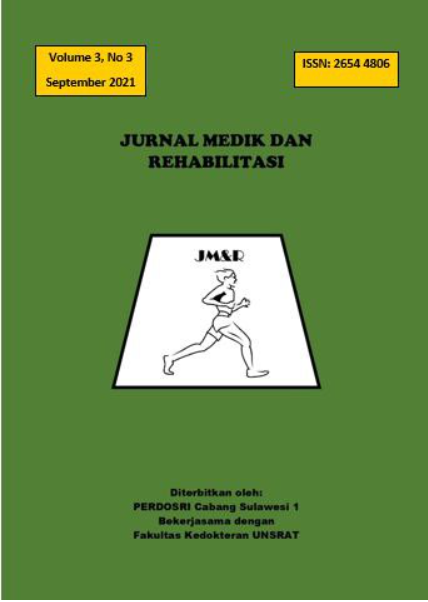REHABILITASI MEDIK PADA AFASIA
Abstract
Aphasia is a communication disorder that usually occurs due to damage to the language-dominant hemisphere of the brain, about 95% of language-dominant hemisphere individuals are located in the left hemisphere. Aphasia is also an acquired focal neurological disorder, in which there is damage to receptive language processing (reading and listening comprehension) or expressive language (speech expression, intonation, gestures, and written expression) or both. Aphasia usually results from lesions in the language areas of the frontal, temporal and parietal lobes of the brain, such as Broca's area, Wernicke's area, and the neural pathways between them. Aphasia usually occurs suddenly, resulting from a stroke or head injury, but it can also develop slowly, as in the case of a brain tumor, infection or dementia.
References
Tan JC. Practical Manual of Physical Medicine and Rehabilitation. St. Louis (Missouri): Mosby; 1998.
Kirshner HS. Aphasia. American Academy of Neurology. 2019
Batson DW, Avent J. Adult Neurogenic Communication Disorders. In: Braddom RL. Physical Medicine and Rehabilitation. 4th ed. Philadelphia: Saunders; 2011. p. 54-57
Dharmaperwira-Prins R, Maas W. Afasia Deskripsi Pemeriksaan Penanganan. Edisi Kedua. Jakarta: Balai Penerbit FK UI; 2002.
Soewito F, Bastian YD. Afasia. In : Ilmu Kedokteran Fisik dan Rehabilitasi. Jakarta : PERDOSRI; 2016. P 562-564
Guyton AC, Hall JE. Textbook of Medical Physiology. 11th ed. Philadelphia: Elsevier Saunders; 2006.
Cuccurullo SJ. Physical Medicine and Rehabilitation Board Review. Park Avenue South (NY): Demos Medical Publishing; 2004.
Subagjo. The Maximazing Function After Ischemic Stroke to Prevent Secondary Attack. In : Soebadi RD, Mei Wulan SM, Santoso B. Proceeding updating Physical Medicine and Rehabilitation toward 2010. 2004 : 118
Solomon B, Brewer C, Brodsky MB, Palmer JB, Ryder J. Speech, Language, Swallowing, and Auditory Rehabilitation. In: Frontera WR, DeLisa JA, editors. DeLisa’s Physical Medicine & Rehabilitation Principles and Practice. 5th ed. Philadelphia: Lippincott Williams & Wilkins, a Wolters Kluwer Business; 2010. p. 420-422
Dharmaperwira-Prins R. TADIR Tes Afasia Untuk Diagnosis Informasi Rehabilitasi. Jakarta: Balai Penerbit FK UI; 1996.
Wirawan RP, Wahyuni LK, Hamzah Z. Asesmen & Prosedur Kedokteran Fisik dan Rehabilitasi. 1st ed. Jakarta. PERDOSRI;2012
Papathanasiou, Patrick C, Potagas C. Aphasia and Related Neurogenic Communication Disorders. Jones and Ascent Learning Company. 2013
Miller RM, Groher ME, Yorkston KM, Rees TS, Palmer JB. Speech, Language, Swallowing, and Auditory Rehabilitation. In : DeLisa JA. Physical Medicine and Rehabilitation
Simon RP, Greenberg DA, Aminoff MJ. Disorders of Cognitif Function. In : Clinical Neurology. 7th Edition. Lange Medical Book/ Mc Graw Hill. New York, USA. 2009 :7-8.
Young PA, Young PH. The Cerebral Cortex : Aphasia, Agnosia, And Apraxia. In : Basic Clinical Neuroanatomy. 1sd Ed. Lippincott William and Wilkins. Philadelphia, USA. 1997 : 197-199.
Best W, Greenwood A, Grasly J. Aphasia Rehabilitation : does generalisation from anomia therapy occur and is it predictable ? a case series study. Cortex. 2013
American Speech-Languange-hearing Association. Speech-language pathology medical review gudelines. Maryland ; American Speech-Language-Hearing Association; 2015.
Kreisler A, Godefroy O, Delmaire C, et al. The anatomy of aphasia revisted. Neurology. 2000 Mar 14. 54(5): 1117-23.
Hillis AE, Gold L, Kannan V. et al. Site of the ischemic penumbra as a predictor of potential for recovery of function. Neurology. 2008 Jul 15. 71(3): 184-9

